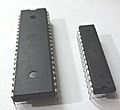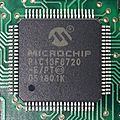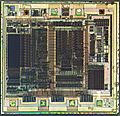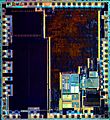Microcontroller facts for kids
A microcontroller (often called an MCU or µC) is like a tiny computer on a single chip. It's designed to do one specific job really well. Think of it as the "brain" inside many everyday electronic devices.
Unlike a regular microprocessor (like the one in your computer), a microcontroller has everything it needs built right in. This includes a CPU (the main brain), memory (for storing information and programs), and special input/output parts. These parts help the microcontroller talk to other things connected to it, like buttons, sensors, or screens.
Microcontrollers first appeared in 1971, thanks to the Intel company. At first, they were quite expensive. But over time, they became much cheaper and more powerful. By the early 2000s, microcontrollers were used all over the world in countless products. Because they are often built right into a device, they are also called embedded systems or embedded controllers.
Contents
What's Inside a Microcontroller?
A microcontroller has several important parts working together:
- CPU: This is the main part that processes instructions and does calculations.
- RAM: This is temporary memory used for storing data while the microcontroller is working.
- Program Memory: This is where the instructions (the program) for the microcontroller are stored. It can be flash memory or EPROM, which keeps the program even when the power is off.
- I/O Peripherals: These are special parts that allow the microcontroller to connect to and control other devices. For example, they can read signals from a button, control a light, or send information to a display.
How Microcontrollers Work
Microcontrollers usually run at much slower speeds than the powerful microprocessors in personal computers. For example, some might run at only 32 kHz (kilohertz). But this lower speed is perfect for their typical jobs, like controlling a washing machine or a remote control.
Another great thing about microcontrollers is that they use very little power. They often use only milliwatts or even microwatts of energy. This makes them ideal for battery-powered devices.
Where Are Microcontrollers Used?
Microcontrollers are everywhere! They are the hidden brains inside many automatic products and devices you use every day. These are called embedded systems.
Here are some examples:
- Cars: They control engine systems, anti-lock brakes, and dashboard displays.
- Home Appliances: You'll find them in washing machines, microwaves, refrigerators, and smart thermostats.
- Electronics: They are in remote controls, toys, power tools, and even machines in factories.
- Medical Devices: Many medical tools and equipment rely on microcontrollers to function.
- Energy Systems: They are used in solar power systems and other energy-saving devices.
They are designed to be small, efficient, and reliable, making them perfect for these specialized tasks.
Related pages
- Arduino
- Atmel AVR
- Intel
- Microprocessor
- CPU
- Texas Instruments
Images for kids
-
Die of a STM32F100C4T6B ARM Cortex-M3 microcontroller with 16 kilobytes flash memory and a 24 MHz central processing unit (CPU).
See also
 In Spanish: Microcontrolador para niños
In Spanish: Microcontrolador para niños






